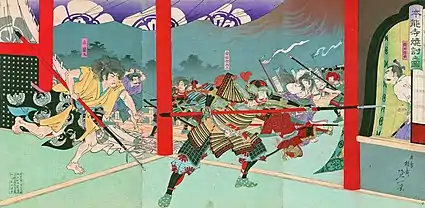Nōhime
Lady Nō (Japanese: 濃姫, Hepburn: Nōhime, Nohime), also known as Kichō (帰蝶), was the legal wife of Oda Nobunaga, a major daimyō during the Sengoku period of Japanese history. Her proper name was Kichō, but since she came from Mino Province, she is most commonly referred to as Nōhime ("Lady of Mino"; Nō is an abbreviation for Nōshū (濃州), other name of Mino Province, and hime means "lady, princess, noblewoman"). She was renowned for her beauty and cleverness.

Nōhime's father was the daimyo Saitō Dōsan and her mother was known as Omi no Kata. Nō herself appears very little in any historical record, and there is little information on the dates of her birth or death; however, proposed dates for her birth fall in 1533–35. According to one historical record, Lady Nō was infertile, and when Nobunaga's concubine Lady Kitsuno gave birth to Oda Nobutada, the child was given to Lady Nō, Nobunaga's legal wife, to be raised as Nobunaga's heir.
Marriage to Nobunaga
Nō was said to be extremely intelligent and stunningly beautiful. At their wedding, Nobunaga described her as having "the mind of a genius and the appearance of a goddess." She was married to him in 1549, during a truce between his father, Nobuhide, and hers (Saitō Dōsan).
The marriage is believed to have been a political gesture, with little actual love between Nō and Nobunaga. Though she was his official wife, it is often believed that he focused his love on his concubine, Kitsuno, who bore him his first son, Nobutada. Nō was never able to conceive a child with Nobunaga, and it was believed that she was infertile.
Through lack of historical record there is not much information of what became of Nō or even the date of her death. Overall, it can be said that Nō's life as it is known now is more of a mixture of legends, folktales, and tentative half-truths. Nō's official grave is at Sōken-in (総見院), a subtemple of Daitoku-ji in Kyoto.
Legends and speculation
One theory posits that Nō was acting as a spy, or even assassin, for her father; at that time it was not an uncommon practice for a wife to relay information to her maiden family. Given Nobunaga's reputation at the time as the unruly "Fool of Owari" (Owari no Utsuke 尾張の虚け), it was also not impossible for Dōsan to want Nō to assassinate him, as she was skilled in both the sword and a selection of martial arts.[1]
As for her alleged role as a spy, there is a popular story where Nobunaga purposely gave Nō false information regarding a conspiracy between two of her father's head servants and their plans to betray him. Her father had both men executed, and thus weakened himself by eliminating those loyal to him.

In 1556, Nō's father, was killed in a coup done by his own son, Yoshitatsu, in Mino Province. This detracted much from Nō's worth as a wife. Her inability to conceive and her supposed spying were held against her.
Incident at Honnō-ji
The fate of Nōhime is uncertain, but it is said that she died in the flames of Honno-ji while fighting with her naginata against enemy soldiers. However it is said that she managed to survive the battle and escaped the flames of Kyoto alive.[2]
After the Honnō-ji Incident which claimed the lives of Nobunaga and his son Nobutada, it was uncertain where Nō went. Some speculate that she died at Honnō-ji, but the woman alleged to be Nō was more often believed to be a dormant prostitute who Oda Nobunaga had taken a liking to. Nevertheless, after the incident, Nobunaga's wives and female servants were all sent to Azuchi Castle, which was Nobunaga's castle of residence. Among the women was a Lady Azuchi (安土殿 Azuchi dono), who was taken in by Nobunaga's second son, Nobukatsu. This Lady Azuchi is widely believed to have been Nō in disguise as she soon after disappeared from Azuchi Castle in the night.
Other survival theory
Afterwards, it was often rumoured that she had attempted to raise her father's clan in Mino under her name. But this rumour also says that Nō had been killed by an assassin sent by the Akechi who had been tracking her down since her escape from Honnō-ji.
The most commonly accepted form of Nō’s life after the death of Nobunaga is that she was under the care of her adopted son Nobukatsu until he was defeated by Toyotomi Hideyoshi, then was under the care of the Toyotomi until her death in 1612.
In fiction
In Sengoku Basara game and anime series, she is depicted as a beautiful and elegant woman who is loyal to her husband, with matchlock pistols, jackhammers and guns as weapons.
In the game Nioh she appears as Yuki-Onna. (In Japanese folklore, Yuki-Onna is a spirit of snow, associated with disappearing children). In Nioh, she was resurrected by the main antagonist and was killed in one-on-one battle with the main protagonist after he is dispatched to Honnō-ji temple to solve mystery behind the snow that appeared out of nowhere in middle of June. In the fight, she uses ice magic and naginata made out of ice.
References
- "近江国輿地志略. 下(巻49至100) - 国立国会図書館デジタルコレクション". dl.ndl.go.jp. Retrieved 2019-04-25.
- 「信長正室・斎藤氏」 『織田信長総合事典』 雄山閣出版. ISBN 4639016328.
